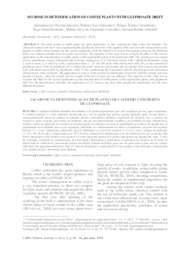Sucrose in detoxification of coffee plants with glyphosate drift.
Sucrose in detoxification of coffee plants with glyphosate drift.
Author(s): ALECRIM, A. O.; GUIMARÃES, R. J.; CASTANHEIRA, D. T.; REZENDE, T. T.; CARVALHO, M. A. de F.; VOLTOLINI, G. B.
Summary: The weed control in coffee plants has great importance, as they compete for light, water and nutrients. The chemical control is the most used, emphasizing the glyphosate, however, when applied, drift can occur and consequently cause injuries to coffee. Many farmers use the sucrose application with the objective to reverse the damage caused by the herbicide drift, even without scientific basis to justify such action. The objective of this study was to evaluate the effect of the sucrose application on the detoxification of coffee plants in the implantation phase with glyphosate drift. The experiment was carried out in a greenhouse, using a randomized block design, arranged in a 3 x 3 factorial scheme with 2 additional treatments, using 3 sucrose doses (2, 4 and 8%) with 3 application times (1, 24 and 168 hours after intoxication with 10% of the commercial glyphosate dose) with an additional one in which the plants were not intoxicated and not treated with sucrose and another only with plants intoxicated by glyphosate. After 75 days performing the experiment, growth, physiological and anatomical characteristics were evaluated. The application of sucrose in the reversal of intoxication of growth variables (height, leaf area number of leaves, shoot dry weight and dry weight of the root system) was not efficient. The objective of this study was to evaluate the effect of the sucrose application on the detoxification of coffee plants in the implantation phase with glyphosate drift. For the physiological variables the application of 2% sucrose, one hour after glyphosate intoxication was the most efficient treatment.
Publication year: 2019
Types of publication: Journal article
Unit: Embrapa Coffee
Observation
Some of Embrapa's publications are published as ePub files. To read them, use or download one of the following free software options to your computer or mobile device. Android: Google Play Books; IOS: iBooks; Windows and Linux: Calibre.
Access other publications
Access the Agricultural Research Database (BDPA) to consult Embrapa's full library collection and records.
Visit Embrapa Bookstore to purchase books and other publications sold by Embrapa.

